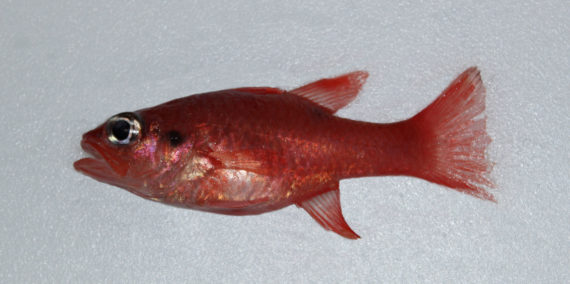Twospot Cardinalfish, Apogon pseudomaculatus
 Twospot Cardinalfish, Apogon pseudomaculatus. Fish caught from coastal waters off Key West, Florida, March 2017. Length: 3.6 cm (1.5 inches). Catch and photograph courtesy of Dean Kimberly, Atlanta, Georgia.
Twospot Cardinalfish, Apogon pseudomaculatus. Fish caught from coastal waters off Key West, Florida, March 2017. Length: 3.6 cm (1.5 inches). Catch and photograph courtesy of Dean Kimberly, Atlanta, Georgia.
The Twospot Cardinalfish, Apogon pseudomaculatus, is a member of the Cardinalfish or Apogonidae Family, and is known in Mexico as cardenal dos puntos. Globally, there are one hundred ninety species in the genus Apogon, of which seventeen are found in Mexican waters, twelve in the Atlantic and five in the Pacific Ocean.
The Twospot Cardinalfish has a small, laterally compressed, and oblong body. They are reddish-dusky overall with a round black spot under their second dorsal fin and another on the saddle of their caudal peduncle. They have a black stripe that extends from their snout through their eyes and to their gill covers and that is bordered above and below by thin silver stripes. The intensity of the black spots and markings within and around the eyes vary significantly from fish to fish. The rear margins of their anal, caudal, and second dorsal fins can be dark. Their head is large with a short pointed snout, large eyes, and a large oblique mouth equipped with bands of small teeth. Their anal fin has 2 spines and 8 rays; their caudal fin is straight; their first dorsal fin has 6 spines; their second dorsal fin is well separated with 1 spine and 9 rays; and, their pectoral fins are exceedingly long. They have 12 to 14 gill rakers on their lower arch. They are covered with rough scales. Their lateral line is complete and extends into the tail base.
The Twospot Cardinalfish is found in a wide variety of habitats including coral reefs, sand, pavement, and low reef outcroppings at depths up to 92 m (300 feet) within water that range in temperature from 22oC (72oF) to 26oC (78oF). They reach a maximum of 11.0 cm (4.3 inches) in length. They are nocturnal predators emerging at night and forming small schools while remaining secluded during the day. They consume small fish and small invertebrates including crab and shrimp. They are one of the rare marine species exhibiting oral brooding; males incubate the fertilized eggs in their mouth for several days before releasing hundreds of larvae measuring 2 to 4 mm into the ocean. Larvae remain in planktonic form for several weeks before developing into juveniles. The Twospot Cardinalfish is poorly studied with very limited information available about their lifestyle and behavioral patterns including specific details on age, growth, longevity, movement patterns, diet, habitat use, and reproduction.
In Mexican waters the Twospot Cardinalfish is a resident of all waters of the Atlantic Ocean including the Gulf of Mexico and the Caribbean.
The Twospot Cardinalfish can be easily confused with the Flamefish, Apogon maculatus (if present, tail spot is elongated not round; concave tail), the Oddscale Cardinalfish, Apogon evermanni (small black spot followed by smaller white spot at base of second dorsal fin), and the Whitestar Cardinalfish, Apogon lachneri (dark second half of anal and dorsal fins). Note: the Twospot Cardinalfish is virtually identical to the Flamefish in both appearance and morphology. I have differentiated the two species presented in this website based on the shape of the tail, i.e. lunate versus straight. Since the majority of these fish come with incomplete markings including the bars through the eyes and the spotting at the base of the tail, DNA profiles are needed to confirm their identities without dispute. I also believe there is a possibility that their DNA profiles will indicate that they are actually one and the same species.
From a conservation perspective the Twospot Cardinalfish are currently considered to be of Least Concern with stable widely distributed populations. The highly invasive Red Lionfish, Pterois volitans, which were recently introduced in the Caribbean are known to consume this Cardinalfish. They are utilized by the aquarium trade as they are easy to maintain but are known to be aggressive toward their tank mates. They are known to spawn in captivity, however, most of their fry do not survive.